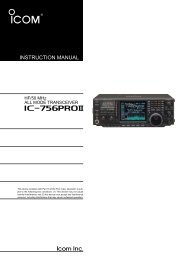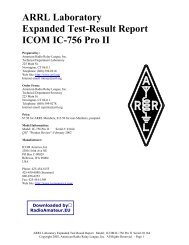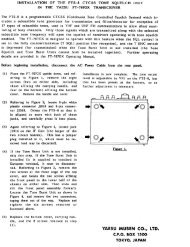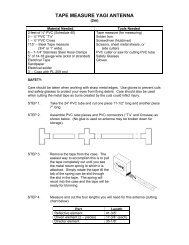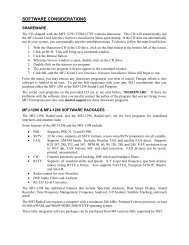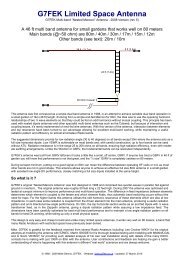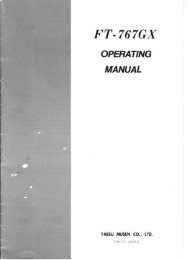Data structure for the ICOM IC-R2 Scanner - OoCities
Data structure for the ICOM IC-R2 Scanner - OoCities
Data structure for the ICOM IC-R2 Scanner - OoCities
- No tags were found...
You also want an ePaper? Increase the reach of your titles
YUMPU automatically turns print PDFs into web optimized ePapers that Google loves.
This diagram clearly shows how data transmitted from <strong>the</strong> computer is reflectedback to <strong>the</strong> computer <strong>for</strong> monitoring of <strong>the</strong> transmission. The diagram alsoshows that radio data is also reflected back to <strong>the</strong> radio so that collisions can bedetected.Because <strong>the</strong> transmit-data line and <strong>the</strong> receive-data line are connected toge<strong>the</strong>r,<strong>the</strong> CI-V interface is connected in a wire-OR configuration. When <strong>the</strong> computertransmits a command, <strong>the</strong> command is automatically echoed back as receiveddata, followed by <strong>the</strong> radio's response to <strong>the</strong> command, if any. For example, if aneleven-byte command is transmitted to a device on <strong>the</strong> cable, and a six-byteresponse is sent, <strong>the</strong> computer will receive a total of seventeen bytes (11+6=17).This configuration allows devices on <strong>the</strong> cable to monitor <strong>the</strong>ir own transmissionsin order to detect interface collisions.A collision occurs when two or more devices transmit simultaneously. If acollision occurs, <strong>the</strong> command must be re-transmitted. The radio or computerthat is transmitting reads its own transmissions back from <strong>the</strong> communicationscable. If it detects that ano<strong>the</strong>r device has transmitted at <strong>the</strong> same time (i.e.<strong>the</strong>re has been a collision) <strong>the</strong> radio or computer stops transmitting, listens tomake sure that <strong>the</strong>re are no o<strong>the</strong>r data transmissions on <strong>the</strong> cable, transmits ajamming code (5 characters of value $FC), and retransmits <strong>the</strong> originalcommand.Question: does <strong>the</strong> cloning system actually follow this part of <strong>the</strong> protocol? Thecloning system seems to assume that no more than two devices will be on <strong>the</strong>cable at any one time and <strong>the</strong> protocol seems to minimise <strong>the</strong> possibility ofcollisions occurring during cloning8



